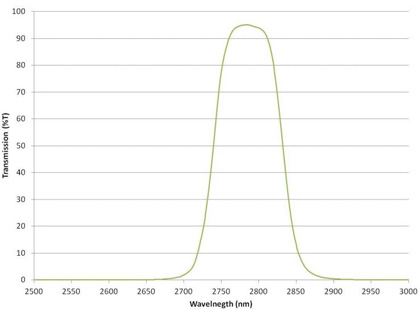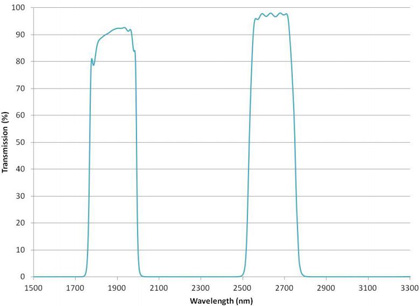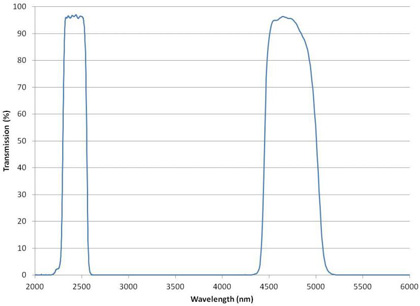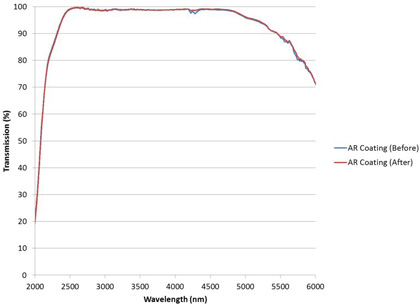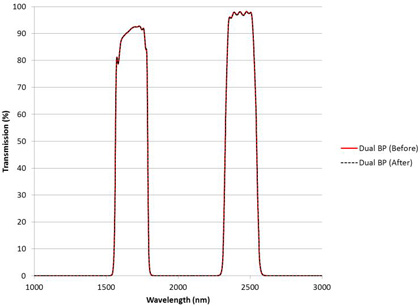Precision Infrared Narrow Bandpass and Dual Bandpass Filters Featuring Low OH-Band Absorption
Alluxa’s new precision infrared bandpass and dual bandpass filter technology brings new levels of performance with higher transmissions, steeper slopes, and flatter pass bands than traditional evaporated coatings.
Alluxa’s new class of Infrared (IR) bandpass and dual band filters bring the precision of dielectric filters to the IR between 2 and 5 microns. They are manufactured with an advanced, plasma enhanced PVD process using durable, hard metal-oxide, and durable semiconductor front surface thin films. The films have excellent environmental stability. The OH (water) band at 2.7 microns shows loss below the measurement limit even after 10 days of harsh Mil-810G temperature and humidity cycling.
Applications
The narrowband and dual band IR filters are the latest innovation in the Ultra product line to come from Alluxa’s novel plasma hard coating process. The filters will offer performance improvements and new design options in a wide range of applications from gas sensing, chemical monitoring, and night vision, to LIDAR and FTIR Spectroscopy.
Bandpass Filter Review
Resonant cavity bandpass filters’ basic design principles are well known and relatively simple. The filters are composed of stacked, resonant Fabry-Perot cavities where quarter-wave stack reflectors are spaced apart by a cavity layer. An excellent book describing the subject further is “Thin Film Optical Filters” by Dr. Angus Macleod. Designing filters to have improved squareness, or steeper slopes, is a relatively straightforward matter of increasing the number of cavities in the filter design. To make a filter narrower, the designer increases the optical thickness of the spacer layer or increases the reflectivity of the quarter-wave stack mirrors. This is analogous to increasing the finesse in any other resonant cavity.
An alternative design approach commonly used in this industry is to combine a Long Wave Pass filter (LWP) with a Short Wave Pass filter (SWP). This design approach is favored for wider filters, and for filters which may have asymmetric slope requirements. Slopes can be increased by simply adding layers to the LWP or the SWP.
Adding cavities to the resonant cavity or layers to the edge filters challenges the deposition process control system, and invariably introduces undesirable ripple and loss to the pass band of the filter. Alluxa has created a new low noise IR optical monitoring system that provides the utmost in layer thickness control, which enables significantly more cavities and layers to be added to designs that are still practical to manufacture. The novel, advanced computer control system constantly measures the filter function and compensates for thickness errors associated
Narrowband Filter with Low OH
Traditional narrowband filters have traces of water incorporated in them during the deposition process, or adsorbed from the atmosphere post deposition due to the porous, low density film structure characteristic of low energy evaporated films.
Alluxa’s new plasma deposition process incorporates essentially zero OH during deposition and the fully dense films have no porosity to adsorb water. As a demonstration, a fully blocked narrow bandpass filter was constructed with a wavelength centered in the water band, shown below in Figure 1. This filter is composed of a multi-cavity bandpass deposited on side 1 with a blocking filter that blocks from the UV to 6 microns on side 2. The substrate material is silicon. The filter is positioned to transmit at the center of the OH stretch band to demonstrate the low levels of OH bonds incorporated in the filter.
Figure 1. Fully blocked narrowband filter centered on the OH-stretch absorption band with transmission > 90% on a silicon substrate.
Dual Band Filters
Optical filters that transmit two pass bands, or dual bandpass, offer different and complex challenges when manufactured. These can be built using resonant cavity techniques, but more often they are combinations of edge filters, notch filters, and/or wide band filters.
Figure 2 and Figure 3 below are two examples of fully blocked dual band filters on silicon substrates. The pass band center wavelengths, pass band widths, and the filter slopes are arbitrary and relatively easy for the designer to adjust.
Figure 2. Fully blocked dual band filter to OD4 level with two independent pass bands feature square filter shape and high transmission.
Figure 3. Fully blocked dual band filter to OD4 average level, with two independent pass bands centered at 2.4 microns and 4.7 microns that feature a square filter shape and high transmission.
Environmental Stability
A variety of filters including Anti-Reflection coatings (AR’s), bandpass filters, and dual bandpass filters, all on silicon substrates, were subjected to harsh environmental stability testing. These filters all successfully passed 10 cycles of the MIL – 810G, Section 507.4 Humidity Testing Procedure, generally considered the toughest environmental test for IR filters. The filters show no change in performance within normal measurement variation because of the dense film structure produced by Alluxa’s proprietary energetic plasma deposition. All filters also passed the snap tape adhesion test.
Because there was no increase in loss or absorption in the transmission measurements, the filters continued to show low OH levels in the film, the results indicating no change within the measurement limit of the spectrophotometers. The results of the AR and dual bandpass measurements made before and after using an FTIR spectrophotometer are shown below.
Figure 4. FTIR measurements of AR coated Silicon substrate covering full water absorption wavelength band before and after MIL-810G testing.
Figure 5. Chart of the transmission of the dual bandpass sample shown in Figure 2 before and after 10 cycles of MIL-810G testing.
Summary
Alluxa’s introduction of IR bandpass and dual band filters are intended to deliver new high performance filter advantages to the IR spectrum between 2 microns and 5 microns. Using Alluxa’s proprietary hard coating deposition process, these filters offer many improvements to designers working in the IR including very high transmission in the water bands between 2.5 microns and 3 microns, full MIL 810 Humidity acceptance, multi-band capability, and Alluxa’s very high transmission and steep edge slopes.
Alluxa
Alluxa designs and manufactures next generation hard coated optical filters using a proprietary plasma deposition process in Santa Rosa, CA. Alluxa’s unique, purpose-built deposition platform and control systems were designed, developed, and built by our team in Santa Rosa, CA to address the demanding requirements of the next generation of systems and instruments. This unique technology allows Alluxa to create the world’s most challenging filters at breakthrough price points.
Contact Alluxa for more information at info@alluxa.com
or visit our website at https://alluxa.com
All content copyright ©2013 Alluxa


